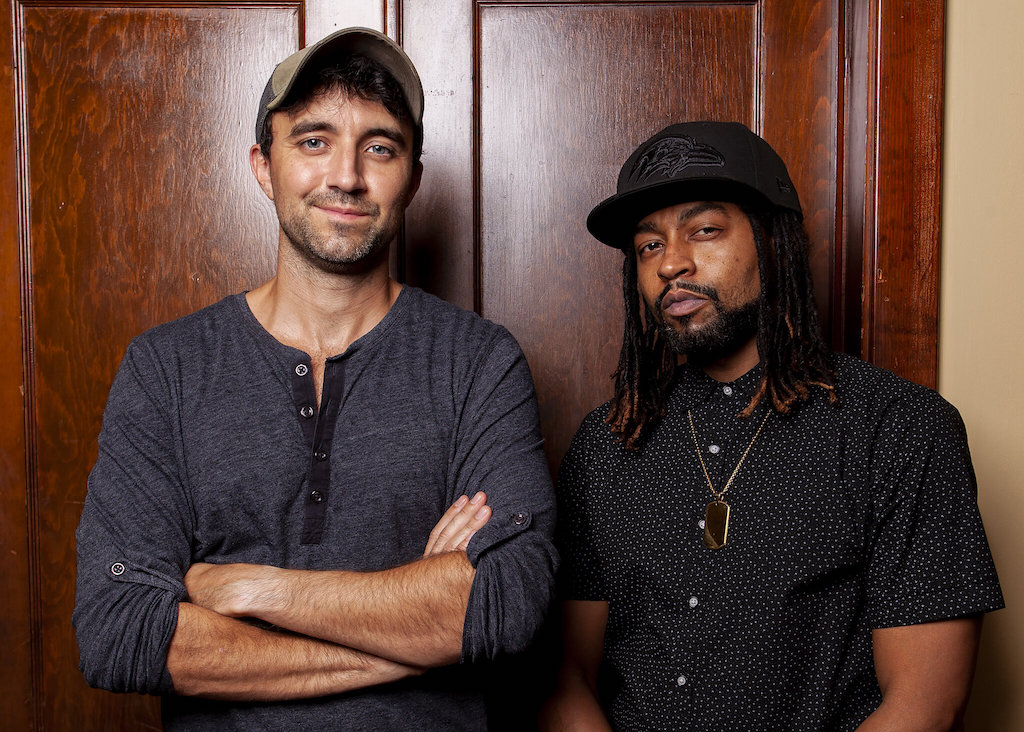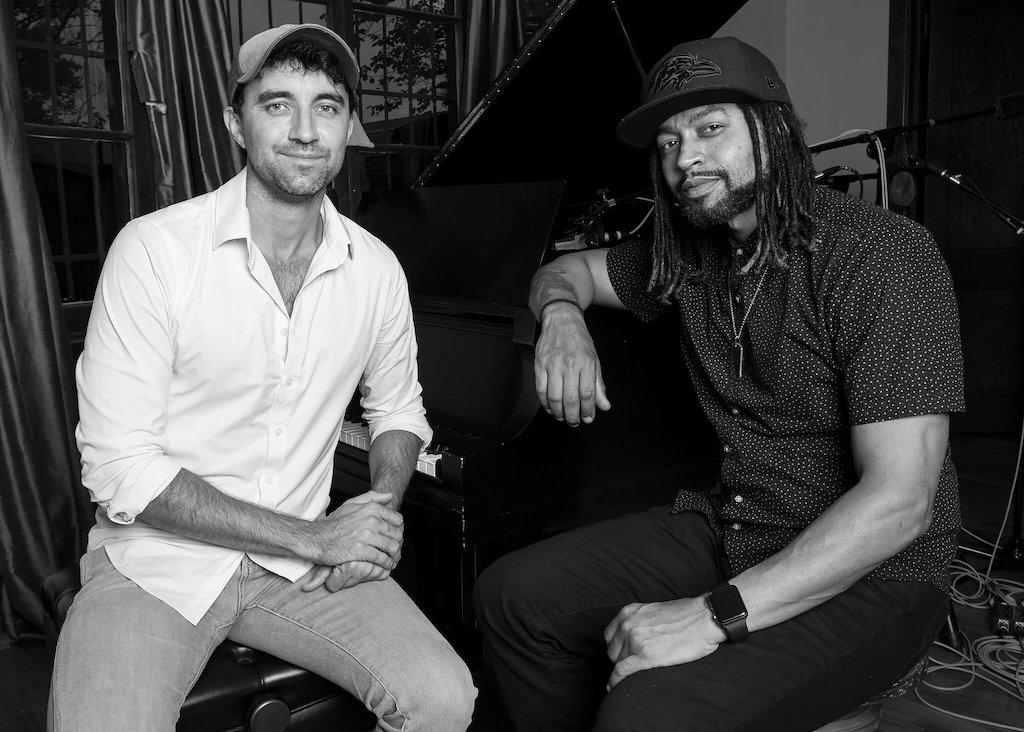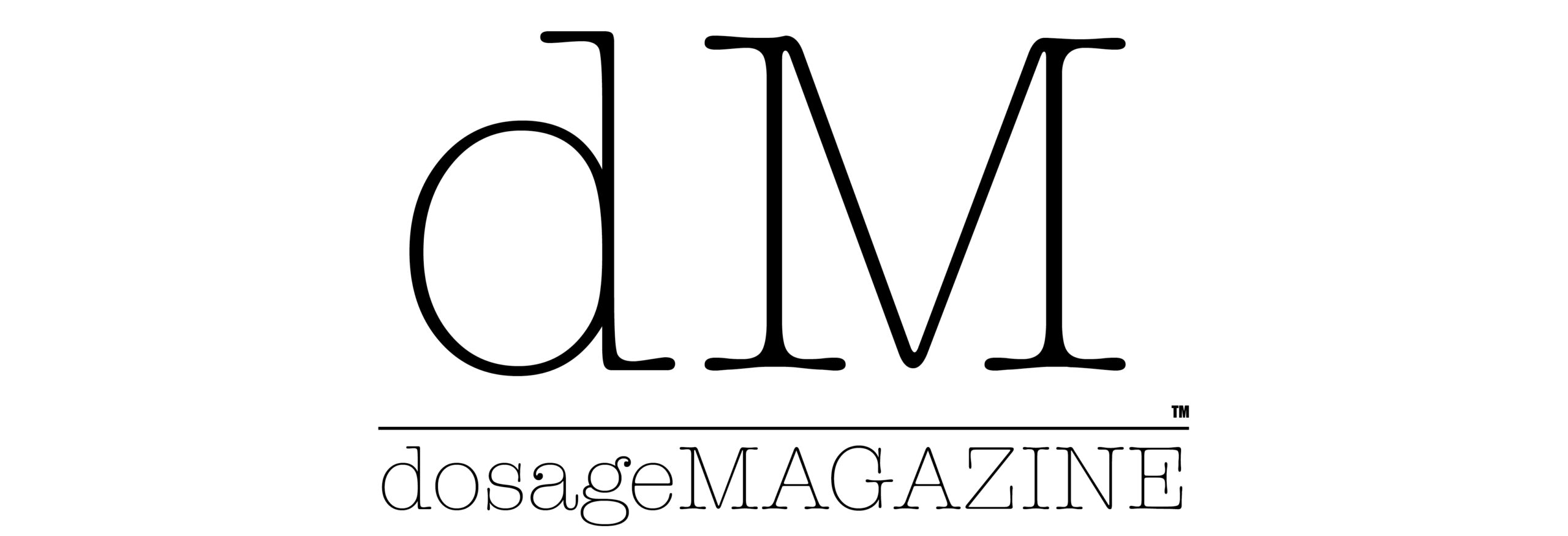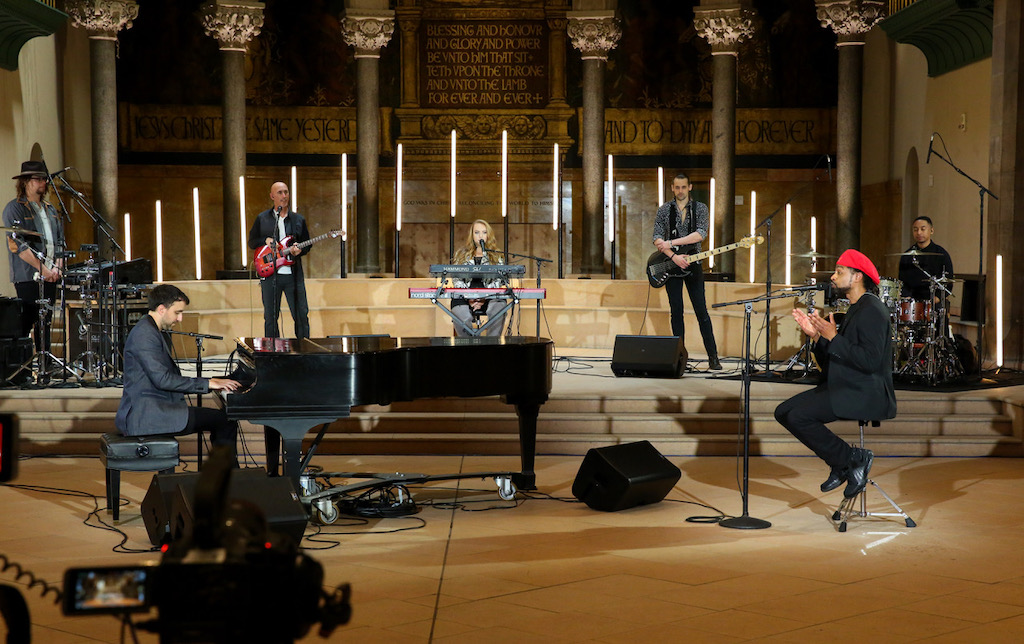
West Philly’s Philadelphia Episcopal Cathedral’s Concert for the Human Family, captured for posterity.
The beloved Philadelphia Episcopal Cathedral, located at 38th and Chestnut Streets in West Philadelphia, is the home base cathedral church of the Episcopal Diocese of Pennsylvania. Beyond its grandeur and its stature, literal and figurative, the Philly Cathedral was recently chosen by the Concert for the Human Family crew – pianist and composer Kory Caudill, rapper and lyricist Anthony “Wordsmith” Parker and multi-instrumentalist Marc Costanzo – to represent cultural diversity through equally diverse musicality. The Technicolor trio and its wide-ranging company of singers, arrangers and musicians recorded and filmed in Philadelphia throughout the end of April 2021, specifically because of the community’s engagement in racial reconciliation work, and, in order to, in their words, “shine a light on topics like the murder of George Floyd and Black Lives Matter, the universal mourning of Kobe Bryant, the intensity of the 2020 presidential election, the weight of COVID on our communities and more.”
Concert for the Human Family just dropped its Philly concert footage online, and will release its American Hymn EP from the sessions ASAP. dosage MAGAZINE and I spoke with Kory Caudill about his group’s ideals and how they got to the City of Brotherly Love and Sisterly Affection in the first place.

A.D. Amorosi: What came first? Someone else’s idea of partnering with The Episcopal Church to create an album of original music to guide audiences in an exploration of the human experience and racial reconciliation work or your own vision, feel for racial, social, communal healing?
Kory Caudill: Before our paths crossed everybody involved was deep into their version of the themes and work that the series is built on. The Episcopal Church representatives initially reached out because the music I had been making was conducive to an initial goal they had in mind, which was simply using their spaces to host events that welcomed all folks back into the buildings. From a logistics perspective, the people on my team are somewhat of a rare breed. They see creative opportunities in situations that aren’t technically conducive to hosting modern concerts. One of my managers had recently spearheaded Yanni’s “Dream Concert” at the Great Pyramids in Egypt, so when he and I visited the cathedral spaces we saw an opportunity, where a lot of industry folks might’ve been hung up on power availability or ten second room reverbs. The enthusiasm we felt at our first site visit, Saint Bart’s Cathedral in NYC, led to a deeper conversation about the possibilities and opportunities facing us. The more we dove in, the more I realized that the church’s folks weren’t just looking for concerts, they were looking for paths towards a stronger community, and ultimately towards reconciliation. The music I was working on prior to them reaching out was already becoming more focused on those traits, and our conversations led to us committing to creating something with the goal of it having a lasting impact beyond concerts. Ultimately we were able to take the things we were already doing separately, and design a fluid platform that allows folks to create in a way that means something to audiences, and hopefully leaves people feeling inspired.
A.D. Amorosi: How does this new music follow in league with what you have done on albums of your own such as Tree of Life? And how does that lead to the original songs you created for this new project?
Kory Caudill: Me and mine didn’t realize it at the time, but I launched my solo career the same year the music industry experienced some of the biggest shifts brought on by streaming and social media. In hindsight, after releasing Tree of Life my focus became more about strategy than it did the music, which turns out made the strategy and the music suffer. Like a lot of new parents, when my daughter Annaleigh was born, my perspective shifted. I grew to approach my original instrumental music in a way that kept me from recording anything as a strategic move. I figured I was in a position to have a small impact on the world she grew up in, and I didn’t want to record music that didn’t mean anything from that point on. This approach expanded tremendously when we decided to prioritize collaborations in the Concert for the Human Family series. The music we’re doing now has similar themes and tendencies as earlier recordings of mine, but I often look back on past releases and think how much better some of those instrumentals might have been if used as a platform for another artist that had a message to share. This project allows me to recognize and accept when I’ve brought a new idea as far as I can take it, and encourages me to make it available for others to expand on it in a meaningful way.
A.D. Amorosi: Are you a religious person?
Kory Caudill: I’m a spiritual person and I’m a person of faith. I grew up in rural Appalachia and my family’s roots are in the Pentecostal church. I was exposed to a very real, pure spirituality that folks in my grandparents’ generation had, which I think transcends religion. Like many, I’ve grown disappointed in how a large portion of our country’s religion has morphed into a political, condescending, exclusive social club that doesn’t resemble anything I grew up with. I began to really separate religion and spirituality and faith when, during a funeral service back home in East Kentucky, the preacher sat aside time to find something rude to say about Catholics. My wife, who was with me, is Catholic and I was really driven away when those comments were made. I do still attend church and I’m thankful for the community it allows me to be part of, but when religion becomes a wedge between people as opposed to a means for loving each other, especially across differences, I’m out.
A.D. Amorosi: How can this music be viewed, heard outside of the sacred, despite its close and immediate ties to a church?
Kory Caudill: I don’t think any music, in any setting, can be experienced outside of the sacred. When you’re experiencing music, you’re experiencing notes and rhythms being borrowed by people and used in a way that makes you feel something, and those notes are returned for the next person when they’re done. I’d consider that a sacred experience whether it’s in a symphony center or in a mosh pit. I do, however, think this music will easily be experienced outside of religion. To date I don’t think we’ve recorded anything that wouldn’t seem appropriate in a jazz club and a cathedral at the same time, all while standing firm in the messaging. If you’re at one of our concerts and you hear Chester Thompson play a drum groove, you’re going to feel something, regardless of your politics or religion.

A.D. Amorosi: The Episcopal Church’s Becoming Beloved Community program… When and how did you connect with them?
Kory Caudill: We immediately saw a natural intersection forming between the concert series and the Becoming Beloved Community program. One of the most inspiring things about the project is that we didn’t set out specifically to write music or design concerts that fit into the program, but it became evident that the way we were merging this series with the music industry acted on a lot of the themes in the Becoming Beloved Community. Once we settled on the two being intertwined it became about learning for me. Before we released music or did anything publicly in relation to the concert series, I spent two years sitting in on conversations, traveling to meet folks, and submerse myself in the work that had already been taking place. I also wanted to make sure I carried those experiences in a way that allowed people I’m around on a daily basis, which is often large groups of country music fans who I love dearly, to feel intrigued by the movement rather than judged.
A.D. Amorosi: Who are your collaborators: rapper Anthony “Wordsmith” Parker and alt-rock artist Marc Costanzo? And why did these two seem right for the job?
Kory Caudill: Marc is my business partner and one of my best friends, so it’s not really a matter of whether or not he’s right for any job, as much as it’s him being part of my creative ventures by default. I’ll preface by saying that the pandemic kept Marc and I from collaborating on this in a manner that would allow him to be comfortable taking much ownership. Had he been able to join us stateside, the two of us would’ve worked crazy hours, spent too much money, and dove deeper into the songs than I already did. While the public knows him as the crazy alt-rocker, the industry knows him as a masterful writer, producer, and developer who can see songs through to perfection in big ways. I wish folks could have experienced me sharing this music with him for the first time. The music doesn’t live anywhere near the genres he and I have built our company on and it doesn’t sound like anything folks would picture us enjoying. Yet here was a pop and R and B producer who’s so loud he can be seen from space, in a room taking deep dives into jazz records with a guy who speaks so country his own wife tells him he needs an English translator, and we both knew our stuff. Marc is probably the most focused person I know, and we work diligently at our roles in mainstream pop and country music. Him not only taking a second to look into this music with me, but also offering his advice and comments, hot commodities in pop music, was extremely valuable. More than anything I could tell he was moved by the music and saw a place for it in the world, which is validating for everybody involved in the project. I met Wordsmith at a concert on a military base in Georgia when he was on the bill with Justin Moore. We’d never been on the ticket with a hip-hop artist and we’re all fans of the genre, so we were eager to check out his set. Wordsmith’s music stands out in every way. His delivery and his message are so precise that he’s able to talk about real world issues in his music, without having to rely on typical moves in order to maintain the grit that we all love in hip hop. I tracked him down after his set to introduce myself and we all hung out later that night. We were quick to learn that our musical differences were very surface level and that we had far more in common when it came to our overall approach to music. Wordsmith has a background in theater, he’s hip to the inner workings of instrumental music, and he uses his voice and words like an instrument. We left our first meeting on the notion that we’d find a way of working together in the future, knowing that the whole thing would look hilarious to folks at first. While I was in the early phases of making music for this project the need for storytelling kept showing, and Wordsmith was the first person that came to mind.
A.D. Amorosi: Talk please all about your experience at Philadelphia Episcopal Cathedral, which was temporarily converted into a modern sound space for the concert, and what that was like?
Kory Caudill: It was extremely rewarding. The building itself is a work of art, and our goal was to use the space in a way that highlighted its looks and sounds, rather than convert it into something it isn’t. Sooner Routhier, who’s currently on tour as lighting designer for Coldplay, did a wonderful job at capturing that vision. The audio side presented some challenges because of how amplified and electronic some of the music is. Those spaces are built to allow voices, pianos, to be heard without amplification. Because of the loud nature of the room, by the time drums, electric guitar, bass and keys were really cooking, the grand piano and vocal mics were capturing just as much of those as they were their primary targets. All I can say in regards to that is that Eric Loomis and Sean Truskowski pulled off some tech miracles that are beyond my comprehension. Typically the musicians would have been asked to adjust their dynamics, which has a large impact on performance, but we were never asked to do that. We were able to play with the intensity that we’re used to in arenas, theaters, and outdoor festivals without causing the sound to be a total wash. Eric even used Melodyne software to fix individual out-of-tune notes on the piano in post-production… It was really fascinating. Our challenges were minimized by the fact that there wasn’t a live audience in Philadelphia, so there wasn’t a need for live sound reinforcement. The uncomfortable side of that is for the most part only the musicians could hear what was being played. We knew that the video crew was likely just hearing drums, which made things a little uncomfortable for me. If people are in the room I want them to be able to enjoy the music, so we’re excited for the next phase that will include in-person concerts.

A.D. Amorosi: Why and how was Philadelphia chosen for this effort?
Kory Caudill: We were originally looking into filming a music video for “I Pray” in Philadelphia because of how the vibes of the city represent the lyrics in the song. The film crew drove in from New York to location scout, we loved Graffiti Pier, and the cathedral was our top choice for the majority of the video. While in the building, Jeremy Tackett, the executive producer, face-timed me and said, “Nah, man, forget the music video. Let’s see if they’ll let us do a concert right here.” From a logistics perspective, the staff was well equipped and overly generous in handling the large scale operation that we were bringing in, and they were focused on doing so in a safe manner. The location allowed for only the Nashville team, most of which had already received a first round vaccine, to have to travel on planes. More than anything, the team in Philadelphia was all ready submersed in the work that we’re trying to bring attention to in the concert series.
A.D. Amorosi: Why perform “Over the Rainbow”?
Kory Caudill: My family has a very special connection to rainbows. They’ve brought us peace during very needed times over the years and I’ve always been thankful for that. Recently, however, the symbol has taken on a new meaning for me. When I perform this song live, I dedicate it to my wife Amanda and our “rainbow baby” Annaleigh. If folks know what the term “rainbow baby” means, they’ve likely experienced, or know somebody who’s experienced tragedy. Amanda and I found that folks too often point to a number of reasons as to why they feel they can’t open up about this kind of loss, and that shouldn’t be the case. Playing this song always gives her and I comfort and we hope that it does the same for folks who listen. More than that, we hope that folks who have had similar experiences no longer feel pressure to tough things out on their own.
A.D. Amorosi: So, what is next?
Kory Caudill: I want this project to outgrow me. I’d like for the work everybody’s put into all of this to translate into something that affects a lot of people, all while becoming a sustainable creative venture in the music industry. If we’re true to our goals and visions for this, once the project is fully up and running, another artist who deserves to be heard should step into my role. All of the musicians currently involved are full time musicians, recording artists, engineers and producers. Our goal is to make time to prioritize this project in a way that gives it the attention it deserves, and for us to allow the experience to bleed over into the things we do every day in the industry. Knowing the folks involved, I’d imagine there will be some really special recordings and performances that happen along the way.

